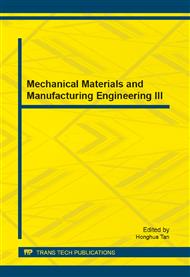p.574
p.580
p.585
p.593
p.598
p.604
p.609
p.615
p.619
3D Design and Performance Analysis of Weft Insertion Mechanism of Carbon Fiber Multi-Layer Loom
Abstract:
The design and research of weft insertion mechanism of carbon fiber multi-layer loom which has the great significance for the development of modern 3D weaving equipment. According to the special requirements of carbon fiber multi-layer weaving fabric, a multilayer weft insertion system incidental finding device is designed, which can be satisfied with multi-layer weft insertion according to the change of shedding position and different layers. In order to meet the sword belt and lifting gear running smooth, kinematic and dynamic analysis and static simulation have been done. Analysis results show that institutions satisfy all work requirements, and have important guiding significance for material selection of components.
Info:
Periodical:
Pages:
598-603
Citation:
Online since:
November 2013
Authors:
Price:
Сopyright:
© 2014 Trans Tech Publications Ltd. All Rights Reserved
Share:
Citation:


